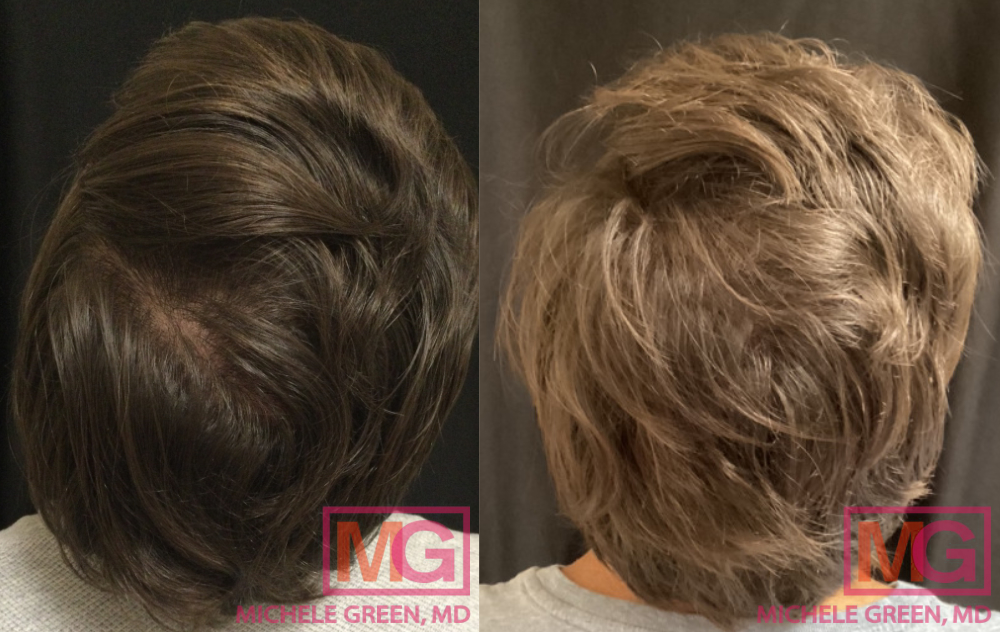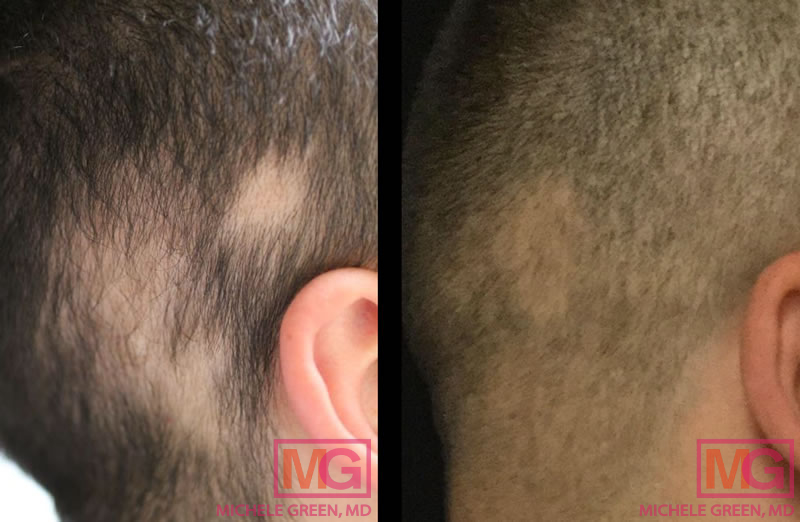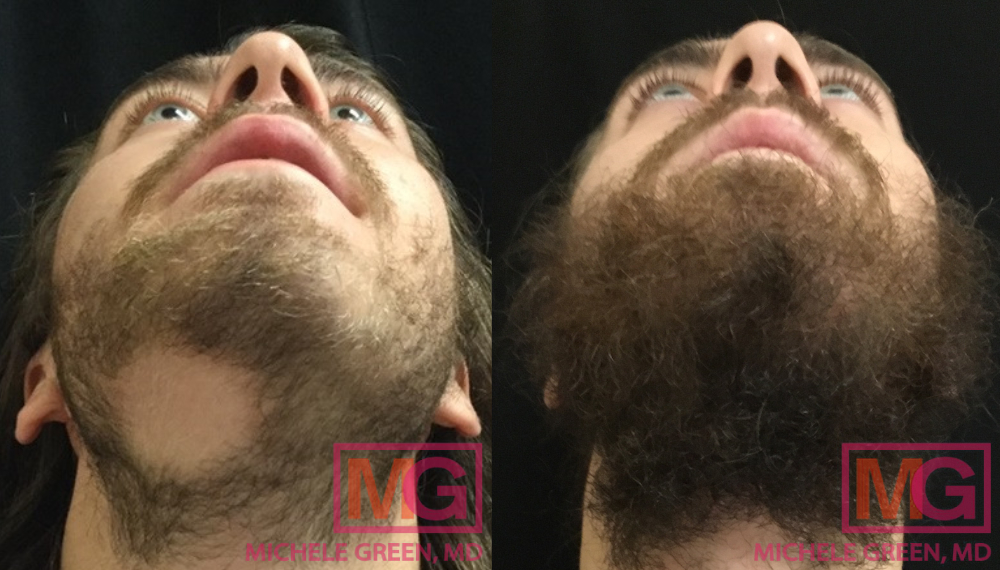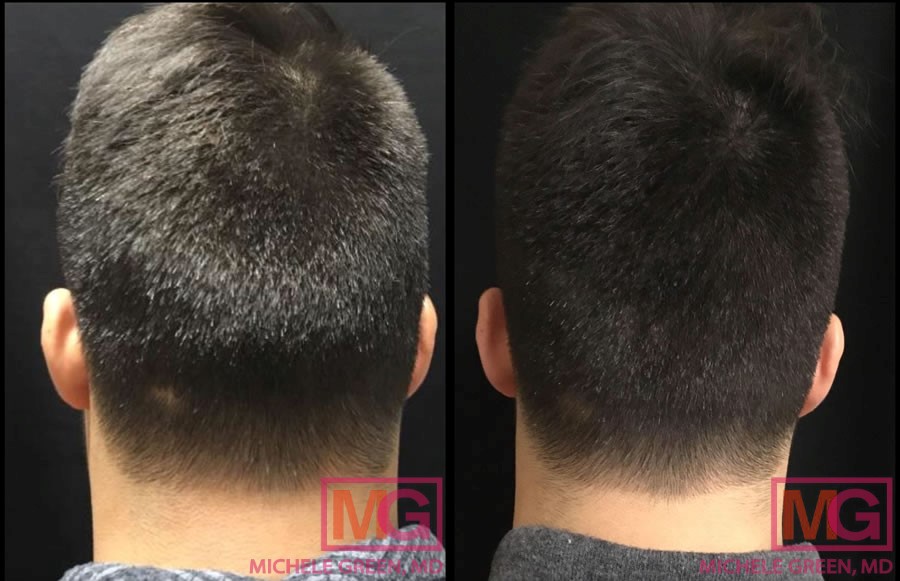Platelet-Rich Plasma (PRP) for Traction Alopecia Hair Loss
Traction Alopecia is a type of hair loss that occurs when consistent tension on the hair gradually destroys the hair follicles, reducing hair growth in the area and, when left untreated, leading to permanent bald spots. The condition primarily affects patients who wear tight hairstyles, such as tight ponytails, braids, weaves, and extensions for an extended period. Patients will typically notice hair thinning along the sides of the head, on the scalp or crown, and in between tight braids, and the risk of developing traction alopecia increases when chemical solutions, such as relaxers, are applied to the hair. Any form of hair loss can be extremely distressing to patients, leading many to seek out hair regrowth treatment options. With many hair regrowth therapies being advertised, it can be difficult to determine on your own which treatment will be effective. That is why it is essential to begin your hair loss treatment by consulting an expert board-certified dermatologist, such as Dr. Michele Green.
One of the most promising medical treatment options for treating many forms of hair loss, including androgenetic Alopecia (also known as male pattern baldness), female pattern hair loss, alopecia areata, telogen effluvium, and traction alopecia, is platelet-rich plasma therapy (PRP therapy). Platelet-rich plasma injections, also known as PRP injections, use a patient’s own blood to boost new hair growth, strengthen hair follicles, and increase hair density for a naturally thicker look to the hair. Platelet-rich plasma injections can also be paired with topical or oral medications, such as minoxidil or finasteride, or with FUE hair transplant surgery to boost new hair growth. PRP sessions are quick and easy to perform with no significant side effects or downtime necessary. When paired with microneedling collagen induction treatment, PRP injections can further boost hair follicle and skin rejuvenation. To find out how PRP therapy fits into your hair loss treatment plan, schedule your initial consultation with Dr. Green.
Board-certified dermatologist Dr. Michele Green has been expertly treating patients in her Upper East Side New York City dermatology office for more than 25 years. Experienced in a wide range of medical and cosmetic therapies, including PRP injections, microneedling, dermal fillers, Botox, laser treatment, and more, Dr. Green always provides patients with the highest quality treatment. When it comes to treating hair loss, Dr. Green is an expert at recognizing different types of hair loss and determining the treatment plan that will most effectively treat the present condition. Well-known for high patient satisfaction, Dr. Green has been voted one of the best healthcare providers in New York City by such publications as Super Doctors, Castle Connolly, and New York Magazine.
What is PRP treatment for hair restoration?
Platelet-rich plasma (PRP) treatment is a highly effective treatment for combatting hair loss, hair thinning, and a receding hairline. The treatment works by extracting a sample of the patient’s own blood and using a centrifuge to separate the plasma from the white and red blood cells. The plasma from our blood draw, when distilled, has a high concentration of growth factors and stem cells that work to regulate proteins, promote cell growth, and stimulate the hair growth process. Many researchers have begun looking at the effects of PRP on hair restoration and found the results to be extremely promising, demonstrating that PRP injections improve blood flow to the treatment area, strengthen and thicken the hair follicle, and increase hair density. PRP treatment is also advantageous in that there is no downtime required following the treatment. Most patients will require multiple treatment sessions for optimal results, and Dr. Green shares the disclaimer that semi-annual PRP sessions will be needed to maintain the effects of the treatment.
What is Traction Alopecia?
Traction alopecia is a type of hair loss that occurs when friction or tension on the hair damages the hair follicles over time. Hair follicles are responsible for new hair growth, and when damaged, hair follicles can stop producing new growth altogether. Tension or pulling on the hair causes the hair follicles to become weaker and weaker over time, and when not treated, can lead to thinning hair and even bald patches. Traction alopecia can be prevented and stopped by taking care not to pull the hair into tight hairstyles for an extended amount of time and cutting down on the use of hair clips or tight head scarves. The effects of traction alopecia can be reversed, but only if the risk factors are eliminated before permanent damage is done to the hair follicles.
Who gets Traction Alopecia?
Traction alopecia is most common in people who frequently engage with tight hairstyles, such as tight ponytails, tight braids, hair extensions, or weaves. These hairstyles can create tension, pulling and damaging the hair follicles over time. People who often wear tight ponytails will begin to see the symptoms of traction alopecia along the sides and in the back of the head, whereas people with tight braids will start to see hair loss occur between the braids. The risk of developing traction alopecia is increased if chemicals, such as relaxers, are applied to the tight hairstyle as well.
What is PRP hair loss treatment for Alopecia?
PRP hair loss treatment has been demonstrated by numerous studies to be effective in combatting the symptoms of several different types of Alopecia, including androgenetic Alopecia, alopecia areata, and traction alopecia. The plasma from the patient’s blood draw is rich in proteins that boost hair regrowth at the injection site. Though not specifically FDA-approved for alopecia treatment, PRP injections are effective in triggering new hair growth, thickening the hair follicle, and increasing hair density at the treatment area. With any off-label treatment, it is essential to seek out a board-certified dermatologist, such as Dr. Green, who knows how to inject the PRP solution for the most optimal results.

Will PRP stop Traction Alopecia?
The best way to stop and prevent traction alopecia is to limit the use of tight hairstyles, such as tight ponytails, tight braids, extensions, and weaves. These hairstyles can pull on the hair follicles, causing damage over time. If traction alopecia is caught early – before permanent damage has been done to the hair follicles – PRP injections can help restore hair growth in the treatment area.
When does PRP for Traction Alopecia start working?
Most patients will require multiple treatment sessions to achieve optimal results with platelet-rich plasma therapy. The amount of time it takes to see the full results of the treatment will depend on the severity of the hair loss that has occurred at the treatment site and each patient’s unique aesthetic goals. Typically, after approximately four treatment sessions spaced 4-6 weeks apart, patients will begin to see the full effects of the PRP therapy about five to six months after starting treatment. The optimal treatment results take time, as PRP injections take advantage of the body’s natural restoration process, providing patients with improved hair growth over time.
Does PRP work for Traction Alopecia?
According to studies published in the Journal of Aesthetic Plastic Surgery and Journal of Cosmetic Dermatology, PRP Injections have been shown to create a significant improvement in hair growth for patients with Alopecia. The research has demonstrated that PRP treatment causes the hair follicles to stay in the growth phase for longer, boosting hair follicle thickness and hair count for a higher hair density. When caught early enough, PRP can significantly improve the appearance of hair loss due to traction alopecia, restoring hair growth to the treatment area. Patients who have significant damage to the hair follicles due to traction alopecia may see less new hair growth in the treatment area.

FAQs about PRP & Traction Alopecia
Does Traction Alopecia come back?
Traction alopecia is caused by tension on the hair, which damages the hair follicles, causing them to become weaker and weaker over time. Tight hairstyles are the primary cause of traction alopecia, and if the use of these hairstyles is decreased significantly early enough, hair should grow back on its own. However, suppose significant damage has already been done to the hair follicles. In that case, it is unlikely that new hair growth will occur without the help of topical medication, oral medication, hair growth supplements, or an in-office treatment like PRP injections. Most of the time, medical treatments like PRP therapy will be sufficient to improve new hair growth. However, if extensive damage has already taken place, patients may need to turn to a hair transplant surgery, which can be paired with PRP injections to achieve optimal results.
What not to do with Alopecia
Following a PRP injection treatment, there are several activities that patients should avoid for at least 24 hours post-treatment. To start, patients should avoid washing their hair for the first 24 hours after receiving PRP treatment but may resume shampooing the next day as usual. Additionally, patients should avoid intense exercise for a full day post-treatment and alcohol or smoking for at least two days post-treatment. Patients should refrain from using blood thinners in the week leading up to treatment and for the first couple of days following the injections.
Which Alopecia is permanent?
There are many different types of Alopecia, which can range in severity and permanence. Traction alopecia can cause permanent damage to the hair follicles if left unaddressed for a long period. The more patients wear tight hairstyles and apply chemicals to the hair, the more damage they will cause to the hair follicles over time. Eventually, the hair follicle will be permanently damaged, keeping new hair from growing in the area. Scarring Alopecia can also cause permanent hair loss, as new hair cannot grow if the hair follicle is destroyed completely. That is why it is essential to consult with an expert dermatologist on the cause of hair loss before undergoing treatment. Certain treatment options will not provide results if the Alopecia has already caused permanent damage to the hair follicle. When you schedule your initial consultation with Dr. Green, she will examine the treatment area and discuss your medical history to determine the treatment plan that will work best for you.
Does PRP work for Scarring Alopecia?
Scarring Alopecia, also known by its scientific name, Cicatricial Alopecia is a hair loss condition caused by inflammation that destroys the hair follicles in the affected area, leading to scarring and permanent hair loss. There are two types of cicatricial Alopecia: primary scarring alopecia, which is caused by an autoimmune disorder that destroys the hair follicles, and secondary scarring alopecia, which is caused by an acute event, such as an injury, burn, infection, or tumor. Depending on the severity of the condition, cicatricial Alopecia can cause visible bald spots where the skin appears smooth and hard. When treating scarring Alopecia, it is important to determine the exact cause of hair loss before beginning the treatment process. For some cases of scarring Alopecia, PRP injections can help trigger new hair growth in the treatment area. However, severe scarring alopecia may not respond to PRP injections on their own. In that case, Dr. Green may pair PRP injections with hair transplant surgery to fill in the bald spot.

Is PRP good for Scarring Alopecia?
PRP therapy can be a very effective solution for some types of scarring Alopecia, such as Lichen planopilaris Alopecia and central centrifugal cicatricial Alopecia. In these types of scarring Alopecia, total hair follicle damage has not occurred, and PRP can be used to restore hair growth to the treatment area. More severe forms of scarring alopecia cannot be cured; rather, treatment takes the form of mitigating symptoms. Maintenance appointments every couple of months are important in creating long-lasting results for the treatment.
Does PRP work for Androgenic Alopecia?
Androgenic Alopecia is one of the most common types of Alopecia, known also as male pattern baldness or female pattern hair loss. The condition occurs in both men and women. It is caused by fluctuations of the androgen hormones, such as dihydrotestosterone, which binds to the hair follicles, causing damage and hair loss. In men, androgenic alopecia hair loss begins at the temples, causing an M-shaped receding hairline before hair loss continues on the crown of the head. In women, androgenic Alopecia typically begins along the top of the head and is characterized by a widening of the part. PRP for androgenic Alopecia has been studied fairly extensively, and studies published in such journals as the Dermatologic Surgery Journal and the International Journal of Women’s Dermatology have shown that PRP injections are highly effective at combatting the condition.
Is PRP good for Androgenic Alopecia?
PRP injections are very good for reducing the symptoms and treating androgenic Alopecia and can even be combined with topical medications for improved results. Research has demonstrated that PRP provides patients with significant new growth after several treatment sessions. PRP therapy helps to increase hair density and hair diameter and boost hair growth by lengthening the growth phase of the hair follicles.
Is PRP good for Traction Alopecia?
When caught early enough, PRP is very effective in reversing the effects of traction alopecia. Traction alopecia is characterized by weakened or damaged hair follicles due to tension or pulling on the hair over time. PRP therapy is most effective if the tension on the hair is also relieved so that there is no additional pulling on the hair post-treatment. PRP injections are effective at increasing new hair growth, hair follicle diameter, and hair density.
Is PRP good for Alopecia overall?
Platelet-rich plasma therapy is a highly effective treatment option for most forms of Alopecia, including androgenic Alopecia, alopecia areata, traction alopecia, and some types of scarring Alopecia. The most important first step in seeking treatment for hair loss is to consult with an expert board-certified dermatologist, such as Dr. Green, who can diagnose the cause of hair loss and recommend the treatment plan that will be most effective. With many treatment options on the market for hair loss, it is essential to find an expert healthcare provider to create your treatment plan.

How to get started with platelet-rich plasma injections for Traction Alopecia today
Traction Alopecia is characterized by hair thinning and loss on the head where tension has pulled and damaged hair follicles. The biggest risk factor for developing traction alopecia is tight hairstyles, such as tight ponytails, braids, weaves, wigs, and extensions that create traction and pull on the hair. If the tension continues for long periods of time, the traction can permanently damage the hair follicles, leading to hair loss. As long as the hair follicles have not been completely destroyed, platelet-rich plasma therapy is a highly effective solution for restoring hair growth to the treatment area. Taken from the patient’s own blood and then centrifuged, the plasma from the blood draw is rich in stem cells and growth factors that strengthen the hair follicles, elongate the growth phase, and create greater hair density. This innovative treatment is available at Dr. Michele Green’s New York City dermatology office.
Dr. Michele Green is an internationally renowned board-certified cosmetic dermatologist with over two and a half decades of experience providing some of the world’s most discerning individuals with the best treatment options, including PRP for hair loss. Taking a holistic approach to hair loss treatment, Dr. Green will recommend a unique combination of oral and topical medical treatments and in-office treatment options to help you achieve and maintain thicker, healthier hair. Dr. Green is consistently identified as one of New York’s best dermatologists by Castle Connolly, New York Magazine, and Super Doctors for her dedication to her patients and expertise. When you consult with Dr. Green, she will work with you to create a personalized hair loss treatment plan that best suits your needs and goals. To schedule a consultation with Dr. Green and get started treating hair loss, please contact us online or call 212-535-3088.
 212-535-3088
212-535-3088